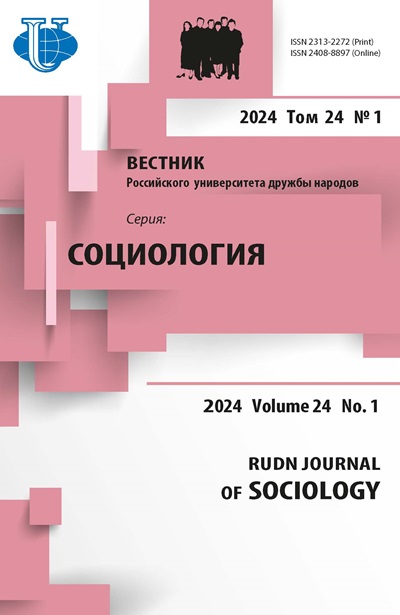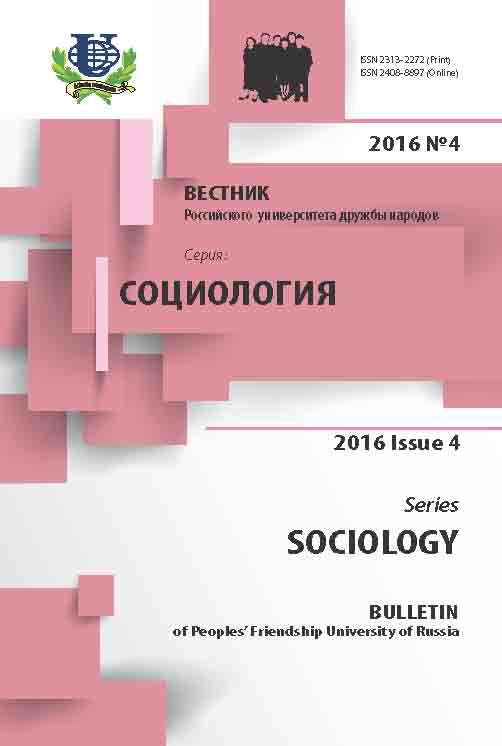Social inequalities in post-reform Russia: A sociological diagnosis
- Authors: Gorshkov MK1
-
Affiliations:
- Institute of Sociology of Russian Academy of Sciences
- Issue: Vol 16, No 4 (2016)
- Pages: 693-718
- Section: Theory, Methodology and History of Sociological Research
- URL: https://journals.rudn.ru/sociology/article/view/14805
Cite item
Full Text
Abstract
The article considers social inequality as a key feature of the development of the contemporary society and social sciences. On the one hand, it is an objective and progressive process without which successful (creative) development of society and individual is impossible; on the other hand, it may lead to dramatic social stratification, provoke a growth of social tensions, and destabilize society. In the Russian scientific discourse the social inequalities and their consequences are explained with the help of two concepts - social-stratification structure, i.e. a multidimensionally organized social space in which social groups differ in terms of possession of power, property and social status; and social strata , i.e. social-economic groups occupying different and unequal places in the macro-social system. The author uses a wide range of empirical (statistical and sociological) data to present the picture of social model in the contemporary Russian society focusing on the dramatic stratification in terms of wealth and the income gap (the decile ratio) widening to a critical mark; interpreting the Russian data in the international context (the current and optimum decile ratio in different countries); identifying statistical and sociological indicators for measuring different aspects of social inequality (for instance, the differentiation of incomes as the deviation of the actual income distribution from absolutely equal); emphasizing regional differences in social inequalities in Russia; and discussing possible mechanisms and means of mitigating social inequalities. The second part of the article presents the results of the national sociological research conducted by the experts of the Institute of Sociology and underlies some other dimensions of social inequalities as gender relations and an access to modern computer technologies and telecommunications and their correct use. The author concludes that the high level of social-economic and other types of inequalities in Russia undermines the social capital of the society and forms an enduring “culture of inequality” which is marked by a high level of aggression and a low level of cohesion.
About the authors
M K Gorshkov
Institute of Sociology of Russian Academy of Sciences
Author for correspondence.
Email: director@isras.ru
Dr. Sci. (Philos.), Academician, Director, Institute of Sociology, Russian Academy of Sciences.
Russian Federation, 17218, ul. Krzyzanowski, d. 24/35, k. 5, Moscow, RussiaReferences
- Belyayeva L.A. Social Stratification and the Middle Class in Russia: 10 Post-Soviet Years. Moscow: Academia, 2001 (In Russ.).
- Golenkova Z.T. Transformation of the Social Structure and Stratification of the Russian Socie-ty. Moscow: IS RAS, 2000 (In Russ.).
- Zaslavskaya T.I. Societal Transformation of the Russian Society: Activity-Structure Concept. Moscow: Delo, 2003 (In Russ.).
- Zinenko I., Vlasova I. Social Inequality in Russia Reaches a New Hight. URL: http://newsland.com/news/detail/id/563868 (In Russ.).
- Mareeva S.V. The idea of justice in the portrait of society Russians dream of. What Russians Dream of: Ideal and Reality. Ed. by M.K. Gorshkov, R. Krumm, N.E. Tikhonova. Moscow: Ves’ Mir, 2013. Pp. 54-76 (In Russ.).
- Milovzorov M.A. The World Turns Bipolar Again. URL: http://www.utro.ru/articles/2008/04/07/728835.shtml (In Russ.).
- Modernization of the Social Structure of the Russian Society. Ex. ed. Z.T. Golenkova. Mos-cow: IS RAS, 2008 (In Russ.).
- Radayev V.V. Social Stratification. Moscow: Aspekt Press, 1996 (In Russ).
- Distribution of Total Volume of Incomes and Characteristics of Differentiation of People’s Incomes. URL: http://www.gks.ru/wps/wcm/connect/rosstat_main/rosstat/ru/statistics/population/poverty (In Russ.)
- Russia: the New Social Reality: Rich. Poor. Middle Class. Ed. by M.K. Gorshkov, N.E. Tikhonova. Moscow: Nauka, 2004 (In Russ.).
- Rutkevich M.N. Social Structure. Moscow: Alfa-M, 2004 (In Russ.).
- Scott J. Gender: Useful category for historical analysis. Introduction to Gender Studies. Part II: Anthology. Ed. by S.V. Zherebkin. Kharkov: Kharkov Center for Gender Studies; St. Petersburg: Aleteia, 2001. Pp. 405-436 (In Russ.).
- Sorokin P.A. Social stratification and mobility. Man. Civilization. Society. Moscow: Politiz-dat, 1992 (In Russ.).
- Tarlavsky V. Rich Man, Poor Man. URL: http://www.eg-online.ru/article/275745 (In Russ.).
- Tikhonova N.E. The Russian roller-coaster (changes in the social structure in Russia in the post-Communist period). A Quarter Century after the USSR; People, Society, Reforms. Ed. by E.B. Shestopal, A.Yu. Shutov, V.I. Yakunin. Moscow: Moscow University Press 2015. Pp. 200-233 (In Russ.).
- Tikhonova N.E. The Social Structure of Russia: Theories and Reality. Moscow: Noviy Khronograf, 2014 (In Russ.).
- Shevyakov A.Yu. Myths and Realities of Social Policy. Moscow: IS RAS, 2011 (In Russ.).
- Shevyakov A.Yu. Inequality and the shape of a new state social policy. Vestnik RAN. 2008. Vol. 78. No. 4. Pp. 304-331 (In Russ.).
- Shevyakov A.Yu. Social policy and reform of distribution relations. Vestnik RAN. 2007. Vol. 7. No. 3. Pp. 195-210 (In Russ.).
- Dahrendorf R. On the origin of inequality among men. The Logic of Social Hierarchies. Еd. by E.O. Laumann, P.M. Siegel, R.W. Hodge. Chicago, 1971.
- Human Development Index and its Components. Human Development Report 2015: Work for Human Development. URL: http://report.hdr.undp.org.
- International Social Survey Program: Social Inequality IV – ISSP 2009. URL: http://zacat.gesis.org/webview/index.jsp?object=http://zacat.gesis.org/obj/fStudy/ZA540.














